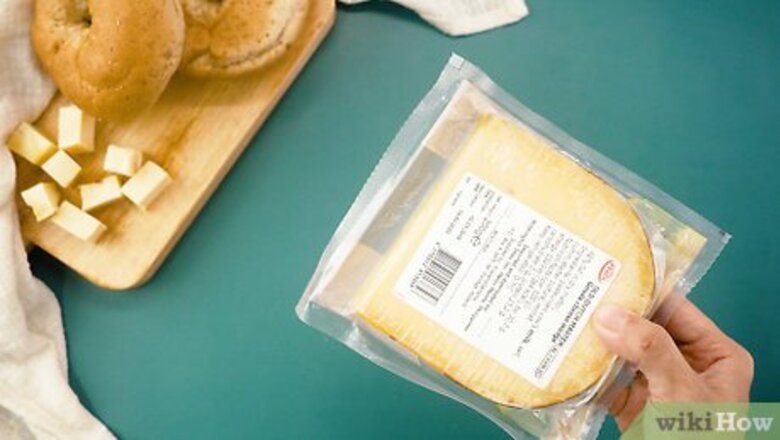
views
Thawing Cheese in the Refrigerator
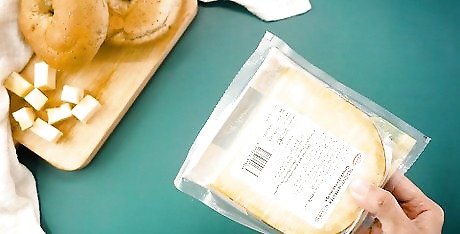
Remove your cheese from the freezer and inspect the packaging. Take your cheese out of the freezer. Look at the packaging carefully to ensure that it’s still airtight. If the cheese wasn’t frozen in an airtight container and was exposed to the air in your freezer, it won’t be edible. Apart from being incredibly hard and flavorless, it may have absorbed bacteria from its exposure to the open air. When cheese has been exposed to air, it becomes oxidized. Cheese that has been exposed to the air for too long will become pale and firm. This is the best method for thawing cheese since it is the most likely to return your cheese to its former texture. Use this method if you’re eating the cheese on its own, slicing it for sandwiches, or using it to garnish a dish. Placing cheese in the refrigerator avoids changing its flavor profile. It is more time consuming than defrosting it on the countertop though. Cheese that has been frozen for more than 6 months may not be edible.
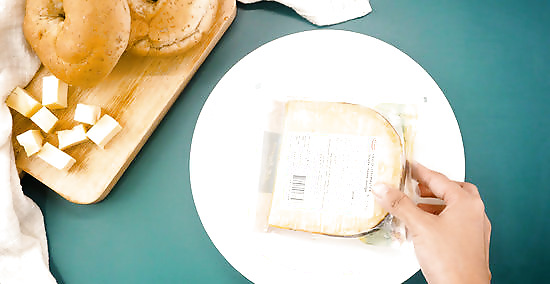
Place the cheese on a plate or baking tray. Leave the packaging on the cheese and do not unseal any zippers or take any tape off. Put the packaged cheese on a plate or baking tray. You can use a bowl or other rimmed container if you prefer. If you open the packaging, you’ll be releasing the moisture that was trapped in the bag from when the cheese was originally frozen. This will make it even drier and more crumbly that it would normally be when it thaws.

Store the cheese in the fridge for 24-48 hours. Take your container and place in on a shelf in your refrigerator. Leave your cheese in the refrigerator for 24-48 hours based on how thick the cheese is. Packages of deli slices can be left for 24 hours, while large bricks of cheese will require 48 hours to fully thaw.Tip: If you’re worried about air getting into your packaging, place the cheese in the vegetable drawer to keep other food smells out.

Remove your cheese from the fridge and use it as quickly as possible. Take your cheese out of the fridge and remove the packaging. Check to see if it’s thawed by trying to cut a piece off. If it cuts easily, it’s fully thawed. Either eat it or throw it in with your recipe to avoid letting it spoil. You can let the cheese come to room temperature before removing it from the packaging if you want to spread it or don’t want to eat your cheese cold. Be careful though, since cheese will start to go bad if you leave it out for more than 4 hours. When cheese starts to go bad, it will start to smell, change color, and taste sour or bitter. You will undoubtedly notice a change in texture after you thaw your cheese when compared to unfrozen cheese of the same variety. The freezing and thawing process typically makes the cheese more crumbly and harder. The softer the cheese is, the quicker it will go bad once it reaches room temperature. Soft cheeses that have been left at room temperature for more than 4 hours should be thrown out. Hard cheeses should be discarded after 6 hours. Soft cheeses include brie, gorgonzola, feta, and ricotta. Hard cheeses include cheddar, provolone, gouda, and Romano. If you’re cooking with it, you can usually cook the cheese when it’s frozen. If you’re melting it or throwing it in a recipe, you don’t necessarily need to thaw it.
Defrosting Cheese on the Counter
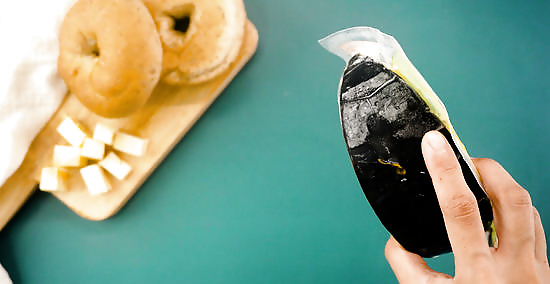
Take your cheese out of the freezer and check the bag or container. Remove your cheese from the freezer and look at the zipper or seal on your bag or container to ensure that it’s still closed. If the air in your freezer got into the packaging, your cheese won’t be edible. Even if it hasn’t absorbed bacteria from the open air, the cheese will have lost a majority of its flavor and will have an unappealing texture. While this method is not the preferred thawing method, it is a lot faster than letting your cheese defrost in the fridge. Select this option if you’re going to use your cheese as an ingredient in a recipe and don’t necessarily care about the texture of the cheese.

Place the cheese and its packaging on a plate or tray. Do not remove the cheese from the packaging that it was frozen in. Place the cheese on a plate or in a bowl and set it out on the counter. You can use some other rimmed container if you prefer.Warning: Don’t leave it next to a window or in the sun while it’s thawing. If you accidentally heat it in the sun, your cheese may start to go bad while it’s thawing.
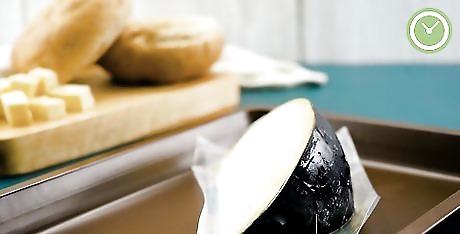
Leave your cheese on the counter for 2.5-3 hours to thaw it. With your container out on the counter, leave your cheese alone to defrost. It will take somewhere between 2.5-3 hours for the cheese to totally thaw. The time required depends on the density of the cheese. Softer cheeses will thaw in 2.5 hours, while harder cheeses may take a little more than 3 hours. Leaving the cheese in its original packaging will ensure that the moisture in the container keeps the cheese from hardening as it dries.

Use your cheese as quickly as possible to avoid letting it go bad. After it has fully thawed, remove the cheese from its packaging. Either eat your cheese or use it in your recipe. If you leave it out on the counter for too long, it will start to go bad, so use it quickly after its been thawed to avoid wasting some perfectly good cheese! If you’re cooking your cheese or using it as an ingredient in a recipe, you can usually use it while it’s frozen. Check your recipe to see if the cheese needs to be thawed first. Bad cheese will taste sour, smell unpleasant, and may change color.
Microwaving Cheese

Unwrap your hard cheese and place it in a microwave-safe container. Take your cheese out of the freezer. Unwrap the aluminum foil or take it out of the container or plastic bag that you were storing it in. Place it in the center of a microwave-safe plate, bowl, or pan. Microwaving cheese is the fastest method to defrost cheese, but it can also lift the whey and milk from the cheese, leaving it oily or wet. Select this method if you’re in a rush, have no other option, or plan on melting the cheese in a recipe. You can only microwave hard cheeses to thaw them. The outer layers of soft cheeses will melt while the interior of your cheese remains frozen. To determine if a container is microwavable, flip the container over and look for “microwave safe” or 3 squiggly lines, which is the international symbol for microwavable materials. Glass and unpainted ceramic are always safe.
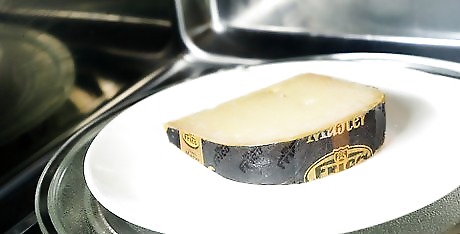
Microwave your cheese on the lowest power setting in 30- to 45-second increments. Place your plate in the center of the microwave. Adjust the power setting on your microwave to the lowest available level. Heat your cheese for 30-45 seconds before taking it out to check it. If it's not thawed, nuke it for another 30 seconds.Tip: If you have a button that says “Cheese” on your microwave, press that instead and enter the estimated weight of the cheese that you’re thawing. Monitor the cheese carefully as it cooks though, as this button may be designed for melting cheese on your specific model. It may take several minutes before your cheese is totally thawed, but working in smaller increments will ensure that you don’t accidentally melt your cheese.
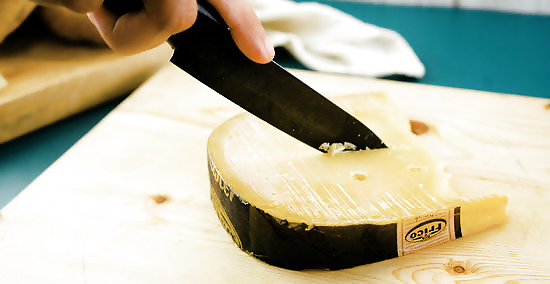
Cut through the center of your cheese to see if it’s thawed. After the microwave buzzer goes off, take your plate or bowl out of the microwave. Use a butter knife to try to cut through the center of the cheese. If your knife moves easily through the cheese, it is fully thawed. If it isn’t easy to cut, put it back in the microwave and continue heating it before trying to cut it again.

















Comments
0 comment